Freyssinet have been awarded the Award for Innovation and its Adoption at this years Construct Awards. The award is for our ongoing works at Hammersmith Flyover in London. The innovation relates to the use of Ultra High Performance Fibre Reinforced Concrete (UHPFRC) as a key element in the Post Tensioning (PT) strengthening system. Freyssinet is extending the life of key structures using advanced concrete with new techniques. The solution UHPFRC challenged the application of design codes, driving new techniques like the development of a unique concrete placement system. These innovations have the potential to change the way we think of future refurbishment of similar concrete structures.

The award and cheque was collected by Kevin Bennett, Sales and Technical Director and Ron Wilkinson, who were both thrilled by the accolade. The cheque was donated to the event’s chosen charity, The Lighthouse Club, who provide support to construction workers and their families.
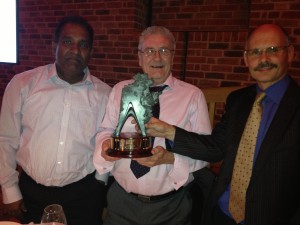
HAMMERSMITH SEMINAR A SUCCESS
Over 40 attended a seminar on ‘Corrosion, Structural Repair and Post Tensioning’ at Novotel London West, Hammersmith on Tuesday 30th September 2014.
Guest speakers included David Halifax, Reinforced Earth Manager and Jon Ball, Associate Director, Roger Bullivant.
Freyssinet’s Southern Repairs Manager, Gary McKenzie was impressed with the level of interest shown in both the talks and the site visit, from delegates across the UK.
Feedback from attendees has been universally positive, including:
“Thank you for the seminar last week, my colleague and I found it interesting and thought provoking.” Hertforshire County Council
“What a most interesting and enjoyable seminar! Your talks were most interesting, full of useful information […] and the trip round Hammersmith was really interesting because as far as I can see it’s are at the forefront of prestress, with the Ductal end blocks and 300m 37/15 tendons ending in blisters. All explained with great knowledge and patience. Thank you to all who took part.” AECOM
FREYSSINET SEMINAR IN HAMMERSMITH, LONDON ON 30TH SEPTEMBER
As part of our commitment to the Construction Industry, Freyssinet will be hosting a seminar in Hammersmith, London to discuss structural repair, geotechnical and refurbishment techniques.
Our new Repairs Manager, Matthew Dronfield will be discussing ‘Bearing Replacement and Application of Different Temporary Works’ and our Managing Director will be giving a talk on works at Hammersmith Flyover, followed by a site visit. There will also be guest speakers from Reinforced Earth Company and Roger Bullivant.
For further information and to book your space, please email info@freyssinet.co.uk.
FIRE DAMAGE REPAIR SCHEME – M6 TOLL DUNTON LANE
Following a lorry fire under the M6 Toll at the Dunton Lane underbridge, significant structural damage had occurred and the M6 Toll engineering team contacted Freyssinet to attend site and assist with the assessment of the damage and work with their design team to produce a suitable repair strategy.
To facilitate the clients key dates for re-opening of the M6Toll, it was necessary to install a central dividing screen on the scaffold. This allowed hydrodem to be undertaken on the East side of the structure whilst spray concrete was being undertaken concurrently on the west side. This made significant time savings to the overall scheme and ensured that the M6 Toll was re-opened in a timely manner.
Water produced during the hydro-dem process was treated on site prior to discharge into the adjacent storm drainage network. The Environment Agency provided consent to discharge prior to the commencement of the works. The water was filtered through geotextile before being PH tested and balanced to PH6-9 before discharge. Following the completion of the hydro-dem process, timber battens were installed to line and level by the joiners prior to spray concrete application.
During the sprayed concrete process, as a consequence of the attention to detail and competence of the spray concrete team, a very high level of quality was achieved with no voids at edges of repairs or behind reinforcement.
The Southern side wall of the structure had sustained surface damage during the fire, but due to the depth of the reinforcement (approx 85mm of cover) there had not been any significant structural damage/exposure of reinforcement to the south wall. The main function of the wall repairs was to restore a suitable ‘finish’ to the concrete surface. The conventional method of undertaking spray concrete repairs is to expose the existing reinforcement in order to allow the spray concrete to bond behind the bars and provide sufficient integrity of the repair. Due to the depth of the reinforcement it was not cost effective to remove the concrete behind rebar, so Freyssinet suggested that the existing concrete was treated with surface preparation by hydro-dem methods to provide a rough surface (CSP 6) which would allow spray concrete to bond to the substrate. Then a layer of reinforcement was introduced to the outer surface of the parent concrete in the form of A393 mesh drilled held in place with drilled and resin fixed 16mm L-bars.
Once the rebar was fixed, timber battens were installed to line and level by the joiners prior to spray concrete being applied. Once the sequenced wall repairs were complete, a ‘flash coat’ of spray concrete was applied to the walls and soffits in order to achieve a uniform textured finish. This was mainly for aesthetic reasons to cover the construction joints.
Whilst the North wall of the structure had not sustained a large amount of damage, there were a limited amount of localised repairs that were treated using flowable repair concrete methods rather than spray concrete.
Hydrodem was used to remove the defective concrete from these repair areas. Through the high level of attention to detail applied by the hydrodem team these repairs were broken out to a very high standard.
CONCRETE REPAIRS, BEARING REPLACEMENT AND JACKING – A38 HARCOMBE CROSS
Harcombe Cross is located on the A38 between Exeter and Plymouth over the B3344, just north of Chudleigh. The A38 Harcombe Cross Bridge is a single span concrete slab deck carrying the A38 dual carriageway above, with a single carriageway underneath. There were paved revetments each side of the carriageway leading to the abutments.
Due to the age of the bridge, the existing 250 tonne capacity bearings had deteriorated and needed to be replaced. Freyssinet were appointed by Enterprise Mouchel to undertake the work in 2013. Freyssinet started work on site in September 2013. The works undertaken included:
• Design, supply and install 2 new guided pot bearings to replace the existing spherical guided bearings
• Design, supply and install 10 new free pot bearings to replace the existing spherical free bearings
• Removal of the existing bearings and creation of jacking pockets into the abutment shelf by hydrodemolition
• Design, supply and installation of a jacking system to enable the removal and replacement of the above bearings.
Freyssinet used special low height pot jacks in a bank of 3no between each bearing. This helped to reduce the pressure of the bearing on the existing concrete, whilst the deck was jacked. The deck was jacked approximately 2mm and the bearings were undermined using hydrodemoliton, by our sister company, Aquaforce. The bearings were then removed. Once the bearings had been removed, second stage concrete repairs were carried out to the deck soffit in the difficult to access areas. Once the new bearing grout and concrete repairs had achieved the required strength, the deck was lowered.
The works were all carried out to the clients satisfaction. They were completed on programme, on budget with no disruption to the A38 above.
BRIDGE REFURBISHMENT – KETLEY AND DAWLEY BRIDGES, M54 TELFORD
Ketley and Dawley Bridges refurbishment scheme on the M54 Telford was undertaken by Freyssinet between July 2013 and March 2014. The works consisted of the following:
• Unsupported phased reinforced concrete repairs to abutments and piers
• Replacement of Ketley East and West central pier bearing shelves and bridge bearings, utilising temporary jacks and support frames.
• Propping the decks from temporary support steelwork supported off the central piers.
• Installation and stressing of Freyssibar in order to retain the steelwork system and transfer the jacking loads into the structure.
• Hydro-demolition of the 16m3 of concrete from each of the 2no central piers. This process was undertaken on 24 hour working in order to maintain the client’s ambitious programme.
• New elastomeric bearings were designed, supplied and installed by Freyssinet in accordance with the client’s design requirements.
• Installation of Cathodic Protection (CP) to the structure including the installation of Advitam Transformer Rectifier our in house supplier of these units. The design of the CP system included the installation of a mesh and overlay Impressed Current CP applied to all of the structures installed by Freyssinet’s highly experienced CP team.
• Spray concrete overlay applied to all surfaces.
Freyssinet were responsible for the access scaffolds for the works. This included the co-ordination of the Record of Design Principles (RDP) process to ensure that the access scaffold was sufficiently designed and checked to avoid impact on the travelling public. Liaison with the traffic management provider to ensure full instigation of procedures.
Freyssinet utilised hydro-demolition for removal of existing concrete. Through liaison with the Environment Agency, we were able to utilise a cost effective method of treatment of hydro-demolition water in order to remove suspended solids and neutralise the water from PH 11 to PH 7-9, before discharge into the highway drainage network.
Welding or reinforcement was undertaken by fully qualified welders who had undertaken weld procedure trials prior to the commencement of the works, in accordance with the chemical analysis/Carbon Equivalent Value of the reinforcement.
Spray concrete was used for the concrete repair process. This proved to be less labour intensive than flowable repairs and curing periods for the material used were beneficial to the programme, as the necessary 29n/mm2 were achieved in 2-3 days, allowing the next stage of repair to commence. Freyssinet had previously undertaken extensive spray concrete repair trials in order to demonstrate that our method of working achieved fully compliant repair, fully encapsulating the reinforcement or de-bonding from the substrate.
In addition to the above specialist items we also undertook the following:
• Refurbishment of decks to 3 no. bridges including:
• Treatment and diversion of existing services, in liaison with statutory undertakers.
• Removal of existing carriageway surfacing, kerbing and resurfacing.
• Waterproofing in accordance with Specification for Highway Works.
• Construction of a new slab over the service bays, which was stitched into the existing deck. The process included the treatment and removal of unforeseen asbestos by a specialist contractor.
• Replacement of buried and mechanical deck joints
NEW BRIDGE REFURBISHMENT PROJECT FOR FREYSSINET
Freyssinet have been successful in tendering for Bridge Refurbishment works at Yanley Viaduct for North Somerset Council with a tender value in excess of £2m.
Yanley Lane Viaduct carries the A370 Long Aston Bypass over Yanley Lane and the main Bristol to Taunton Railway. Parts of the 45 year old Viaduct have become worn and heavy use means that maintenance work is required to prevent further deterioration.
As part of the works Freyssinet will undertake concrete repair, bearing replacement and cathodic protection, amongst other works. We are due to start work on site in August.
For more details on this exciting project contact us on info@freyssinet.co.uk
PROVIDING SPECIALIST CORROSION PROTECTION AT BIGGIN HILL
Freyssinet were contacted by our client who required the services of a specialist cathodic protection provider. During construction of a steel framed building it was found that steelwork provided had potential corrosion risks as a result of sub-contract supplier issues. In order to facilitate the long term adequacy of the structure, an investigation was undertaken which identified potential inadequacies in the corrosion protection methods to the steelwork at the multi storey housing development at Main Road Biggin Hill.
Freyssinet through its subsidiary CCSL and in close association with Mott MacDonald carried out a design for the corrosion protection system proposed for the steel work. For the steelwork in voids, a corrosion inhibitor was installed. This provides the steelwork with a minimum of two years protection.
For the steelwork forming the frame to the car park area and at roof level, Freyssinet embedded within masonry an impressed current cathodic protection based on Elgard 100 Anode Mesh Ribbon providing 3.5m A/m system. A permanent 6V power supply was installed to each of the three blocks in order to ‘energise’ the system. For the steelwork supporting hollow core slabs and isolated areas, galvanic cathodic protection was installed. Mapishield E25 self adhesive Zinc Layer plate was installed.
The system was fully commissioned on 2nd December 2013 by representatives from both Corrosion Control Services Limited (Freyssinet’s Corrosion Control Subsidiary) and Mott MacDonald.

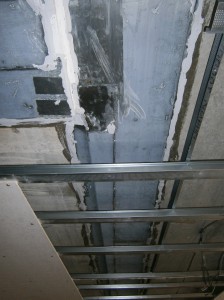
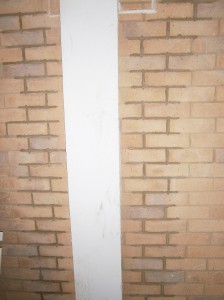
FREYSSINET COMPLETE A CONCRETE REPAIR AND BRIDGE BEARING REPLACEMENT JOB AT THE M6 TOLL OVER THE RIVER COLE
The M6 Toll, also called the Birmingham North Relief Road (BNRR), connects M6 Junction 4 at the NEC to M6 Junction 11A at Wolverhampton with 27 miles (43 km) of six-lane motorway. Proposals were initially circulated in 1980. There followed two public enquiries, one in 1989 and another in 1994. Midland Expressway Ltd were awarded the contract in 1991 and construction work started in 2002. The M6 Toll was opened in December 2003.
Freyssinet were engaged by Midland Expressway Ltd to carry out inspections on a number of structures on the M6 Toll Road. During these inspections, it was identified that existing longitudinal guide bearings on the River Cole Bridge were defective. These bridge bearings were adopted by the toll road from existing road networks. Freyssinet were then instructed to provide a solution to re-instate the required guidance of the deck.
Once the technical solution proposed by Freyssinet had been agreed with the Client’s engineers, Mouchel Ltd, Freyssinet designed, manufactured and installed 12no new mechanical guided bridge bearings. Once these bearings were operational, the existing 24no defective bearings were removed and the bearing shelf local to these bridge bearings were re-instated to the original dimensions.
The Bridge carries the M6 Toll Road over the River Cole. This posed a number of issues which had to be agreed with the Environment Agency. The works were all undertaken in a flood plain of the River Cole. The Environment Agency requested that nothing was left in the flood plain to prevent blockages down stream in the event of a flood. To ensure compliance with the above, we designed the scaffolds to be fully fixed to the bridge, so that if a flood did occur, the scaffolds could not be washed away. This required significant liaison with the Environment Agency to ensure that the flood defence consent was agreed. The works were completed on programme on budget and both the client and the Environment Agency were pleased with the outcome.
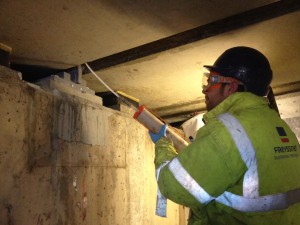
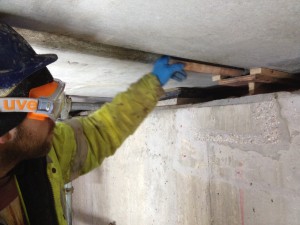
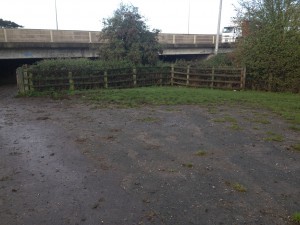
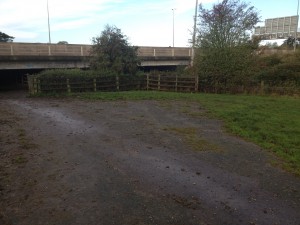
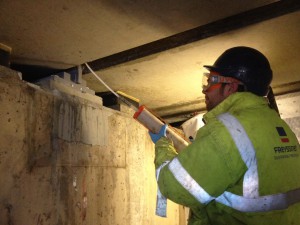
CORROSION, STRUCTURAL REPAIR AND POST TENSIONING SEMINAR – LEEDS 28TH JANUARY 2014
Over 40 attended a seminar on ‘Corrosion, Structural Repair and Post Tensioning’ at Leeds United Football Club, Leeds on Tuesday 28th January 2014.
Guest speakers included Graham Povey, Temporary Works Consultant and Dr Chris Atkins, Associate, Mott MacDonald.
Freyssinet’s Northern Repairs Manager, Phil Watkins-Smith was impressed with the level of interest shown from around Yorkshire.
Feedback from attendees has been universally positive, with many questions being asked of Phil and the guest speakers throughout the event.
Feedback from the seminar included:
“Thanks for putting the seminar in place – the presentations were very good and of great interest.”
Highways Agency
“Thanks for the invitation and for organising […], I found it very useful. If you could also keep me posted on any future events you have planned I would be grateful.”
Leeds City Council
“I enjoyed the seminar […] and found it very informative.”
Jones Lang LaSalle
